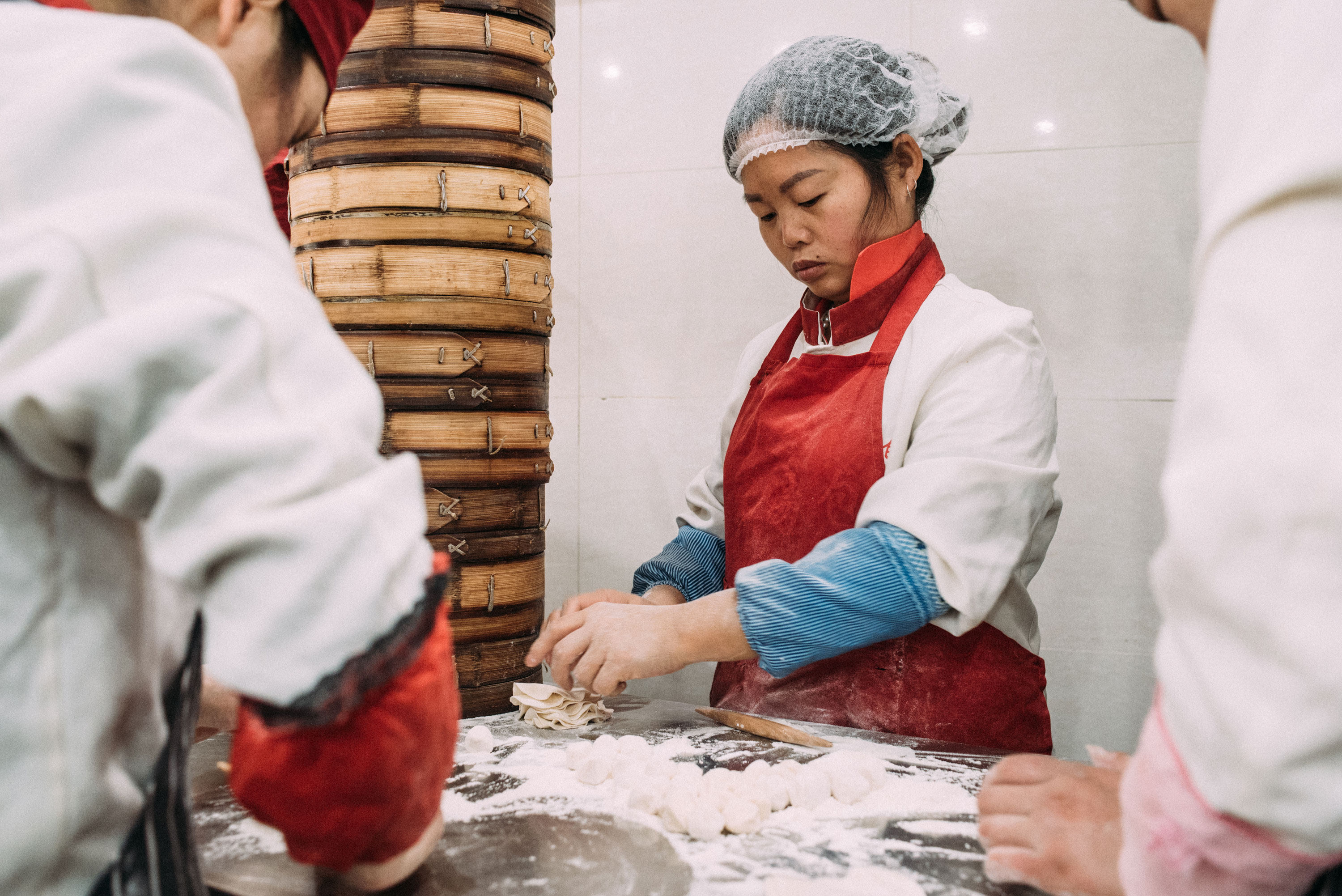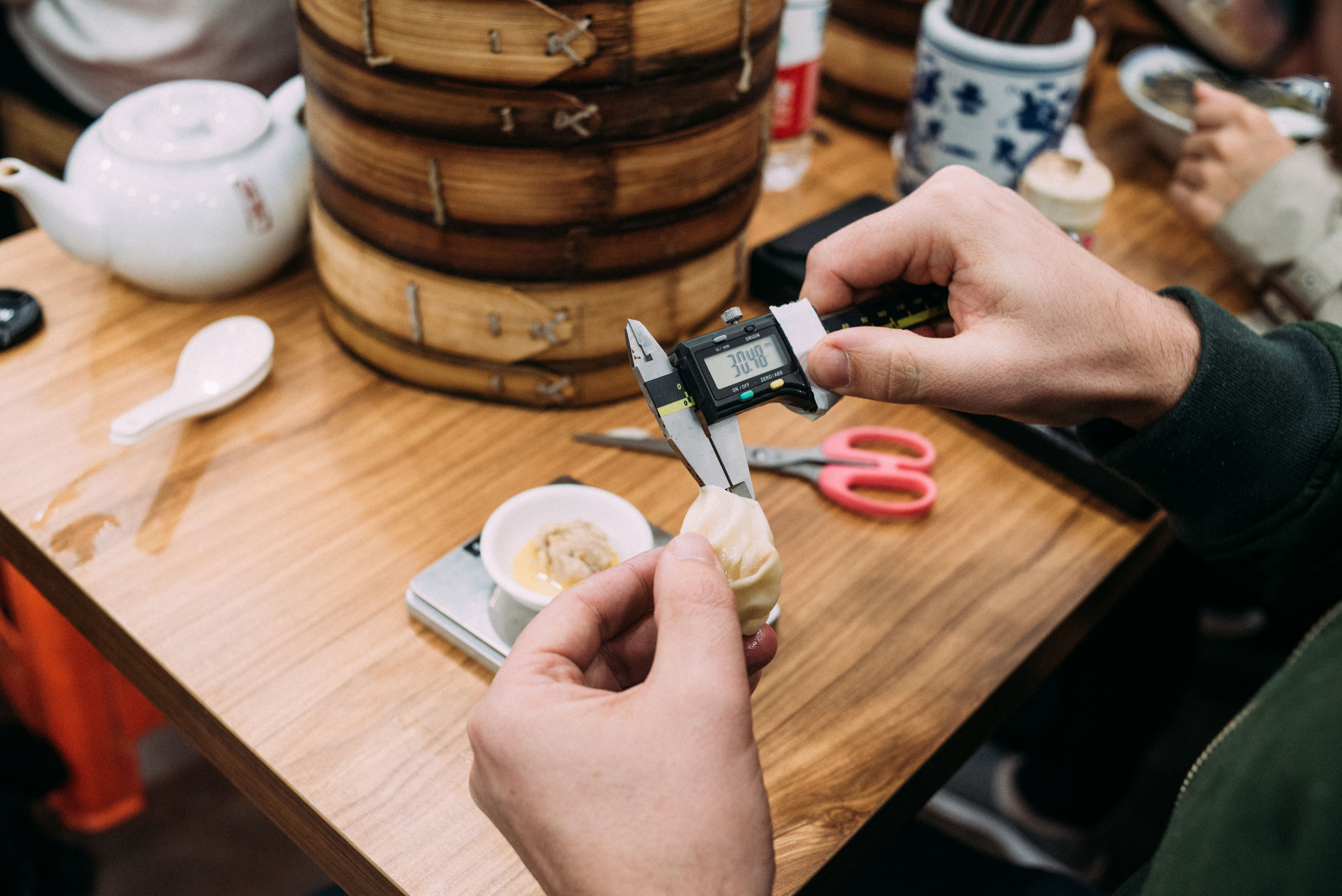“I’m here. Green jacket, black hat, calipers.”
Christopher St. Cavish is easy to spot in the queue outside Jia Jia Xiaolong Bao in Shangahi. It’s 10 AM but the line is already snaking from the restaurant out onto the street. Xiaolong bao, little dragon dumplings, are one of the city’s most famous snack foods. Typically made with pork and a thin wheat skin, the small dumplings become filled with meat juices when steamed. As you take a bite, the whole thing explodes in your mouth. For a little dragon, it packs a punch.
Videos by VICE

Customers queue outside Jia Jia Xiaolong Bao, a popular dumpling spot in Shanghai. All photos by the author.

Xiaolong bao, a soup dumpling usually made with pork.
St. Cavish came to Shanghai from the US 12 years ago as a chef and is now a well known writer in the city. One of his most notable pieces of work is the Shanghai Soup Dumpling Index, a scientific investigation into the quality of Shanghai’s xiaolong baos. Armed with calipers and a digital scale capable of measuring to within 0.1 grams, St. Cavish travelled to 52 different xiaolong bao restaurants, taking four measurements: the weight of the intact dumpling, the weight of the soup, the weight of the filling, and the thickness of the skin. He then applied the following formula:
[(Filling + Soup / Thickness of Skin) x 100]
The data was used to calculate a score representing the quality of the structural engineering of the bao, which is the major challenge for any xiaolong bao maker.
“Why?” you might ask. St. Cavish says that he was driven by an impulse to take a food that in Shanghai is ubiquitous to the point of being invisible, and forcing us to look at it from another perspective.

Christopher St. Cavish, author of the Shanghai Soup Dumpling Index, measures dumplings at Jia Jia Xiaolong Bao.

The weight of the soup, pork filling, and intact dumpling are weighed using a small scale. St. Cavish also measures the thickness of the skin with calipers.
As a chef, and also as someone who has spent a significant time quantifying food, I am curious as to whether he considers cooking an art or a science.
“It’s both,” St. Cavish replies. “My project was both serious and a satire. The one thing I didn’t measure was taste, and that’s the ironic part. You eat these because they’re delicious. They’re not Soylent.”
There’s also the fact that quantifying taste is virtually impossible.
“They have an ‘electric tongue’ that can measure quite a few aspects of taste,” he explains, “but that’s only used by massive food conglomerates and obviously has little to do with intangible aspects of taste like positive associations with the past or your current mood.”

Weighing the pork filling.
What makes a good soup dumpling is simple: thin skin, lots of meat, and lots of soup. Despite these seemingly basic requirements, there’s almost infinite variety between how xiaolong bao restaurants interpret the ratios, what they make the skin out of, and how they prepare the meat.
St. Cavish wants to show me Jia Jia Bao because, as he sees it, the eatery is one of the top practitioners of a certain school of xiaolong bao-making.
“There are two schools,” he says, acknowledging that he made up the idea of there being two schools, “one like this, which is an extremely delicate and light soup dumpling, and another, heavier one, which puts the emphasis on the pork filling and doesn’t try to keep the skin within any particular bounds of thinness.”

In the kitchen at Jia Jia Xiaolong Bao.

Unlike other soup dumpling spots, the bao at Jia Jia Bao are steamed to order. This means they don’t sit. This is a good thing, because if a soup dumpling sits, the liquid and the fat fills the skin and turns it into a thick and gloppy mess.
“A sitting soup dumpling is a sad soup dumpling,” says St. Cavish.
Jia Jia Bao was started by a wealthy couple who suffered persecution during the Cultural Revolution and lost everything. They were poor well into the 1980s, when they realised they had no hope of employment and thus would have to make their own livelihoods. They decided to try to remake the snacks their servants had made them as children. They got a small shop on Penglai street and started to cook from memory.
The results were mostly terrible—except the xiaolong bao. The couple soon built a local following and in the late 1980s and early 1990s, Hong Kong pop stars started touring Shanghai and discovered Jia Jia Bao. They started a buzz around the dumplings that lasts to this day.


The Jia Jia dumplings are as advertised—made to order, delicate, and with thinner skin than a certain small-handed world leader. St. Cavish pulls out his callipers, which come in a very smart black box, and zeroes his scale. He first measures the dumpling whole (23.5 grams), before pulling out a pink pair of scissors and snipping a corner of the dumpling skin. Next, he pours the liquid into a small bowl on top of the scale. Once he has recorded that (2.4 grams), he pushes the meat out (8.9 grams.) The skin, which he uses the callipers to measure, is 1.25 millimetres thick. Using the Soup Index formula, this dumpling sadly comes out at 9.04, which only makes it a Class B dumpling.
Surprised, I ask St. Cavish why such a superlative dumpling scores relatively low on the scale. He points out that we’ve ordered a crab and pork xiaolong bao, and they produce less juice than a pure pork bao. The pure pork have sold out already, despite it being 10 AM (though in China, no one ever sells out of pork, and a glance into the kitchen shows large piles of pork being used to make the pork and crab filling baos. Considering pork and crab sells for 29 Renminbi and pure pork only 13 Renminbi, it’s almost certainly a strategic “selling out.”)
Under the strict conditions of the Index, St. Cavish would have excluded the pork crab and returned another day, earlier, to test them. On the Index, Jia Jia got a handsome 12.49—a Class A dumpling through and through.

The dumplings at Jia Jia Xiaolong Bao are filled with crab and pork.
Unsurprisingly, two white guys—one of them measuring a dumpling with scales, and the other taking photos with a DSLR camera and recording their conversation with a Dictaphone—quickly attract a fair amount of attention in this local dumpling shop. When St. Cavish explains the Shanghai Soup Dumpling Index to a father-and-son pair from Beijing, the Dad nods, before making his son take a photo with his phone. “Maybe you can learn from this,” he says approvingly.
As we take a cab over to Fu Chun, our second stop, St. Cavish concedes this is probably the most attention he has received measuring the dumplings.
“I think most of the time, people would see me with the scissors and just think ‘Wow, this foreigner literally has no idea how to eat our food.’”

Fu Chun, another xiaolong bao restaurant.
Arriving at Fu Chun, St. Cavish reminds me that this is a different school of dumpling: “This is not delicate at all.” We order and look for a seat, but none are immediately available.
“You have to lurk,” advises St. Cavish, before standing next to a small table where two girls are half way through large soups. All around the restaurant, people stand next to diners, tapping their feet and casting long glances at anyone dallying over their dumplings.
We get seats and then the dumplings arrive. St. Cavish rocks the steamer box and the dumplings don’t jiggle at all. These are made of sturdier stuff than the limp whispers at Jia Jia.

Pork dumplings at Fu Chun.

“This is all about the pork. These dumplings essentially are saying, ‘Yeah we have a wrapper, it’s there, but it’s not what we’re about,’” says St. Cavish.
He’s right. The skin is noticeably thicker, which is understandable, because inside they contain weapons-grade pork. The flavour is stronger than any meat I’ve ever had in the West (we’ve bred the pork flavour out, notes St. Cavish), and after three of them, I feel as if the room is starting to slide out from under me. The guy sharing our table pipes up to ask if St. Cavish is a scientist—he’s spotted the callipers and the scales. When St. Cavish says he’s more a foodie, the guy laughs. “A very scientific one,” he says.
After Fu Chun, we go for a walk—a much-needed 20-minute stroll through Jing’An on a pollution-less spring day, the pale blue sky lofty and cloudless. We arrive at Shan Shan Xiaolong, a traditional Shanghainese-style canteen.
“I’ve never seen this place written up in English before,” says St. Cavish, but that’s not why we’re here. We’re here to try the Wuxi-style xiaolong bao, a regional version of the dish popular in Shanghai.

The dumplings at Shan Shan Xiaolong, a Shanghainese-style canteen.

Cutting the dumpling to weigh the filling inside.
It’s a bigger dumpling—more like Fu Chun’s—but the filling is different. There is soy and sugar inside, which means that when St. Cavish cuts the skin and leaks the dumpling out, the liquid is a dark brown. It also means that the dumpling tastes like Coca Cola, and neither St. Cavish nor I are sold on it. But, in true Index-style, we aren’t here for the taste. St. Cavish pulls out the callipers and the scales. It’s a giant—50.1 grams altogether, with 11.1 grams of soup and 18.9 grams of meat. The skin, inevitably, is thicker, coming in at a solid 1.75 milimetres. Yet because of its gargantuan size, it would have scored 17.4 on the index, making it the fourth best dumpling overall.
“I decided on balance that it wasn’t fair to include the Wuxi-style ones,” says St. Cavish. “They skew the results.”
When I ask if he’s thought about quantifying any other food stuff, he mentions another Shanghai favourite: shengjian bao. The shallow-fried dumpling is famous for its crunch. But crunch is impossible to measure.
“I checked the academic literature,” says St. Cavish, “potato chip scientists spend their life on this, and they can’t find an accurate measure because it’s transmitted as sound through your jaw bone. If you were to eat a fresh potato chip with earplugs, you’d think it was stale.”

As we finish up, while St. Cavish cleans his calipers and delicately places them back in the box, I ask him if there is a takeaway to all this—other than the foibles of quantification. He pauses for a few moments.
“That’s an obvious question, but it’s actually pretty hard to answer,” he says, no doubt reflecting on the 52 restaurants he visited over the 16 months he spent compiling the index.
“The simpler it is to do something, the harder it is to do well,” he concludes.




